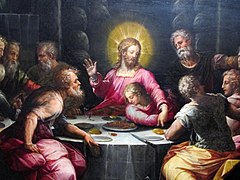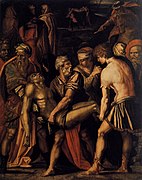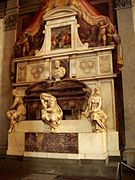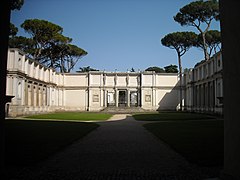art.wikisort.org - Artist
Giorgio Vasari (/vəˈsɑːri/, also US: /-ˈzɑːr-, vɑːˈzɑːri/,[1][2][3][4] Italian: [ˈdʒordʒo vaˈzaːri]; 30 July 1511 – 27 June 1574) was an Italian Renaissance Master, who worked as a painter, architect, engineer, writer, and historian, who is best known for his work The Lives of the Most Excellent Painters, Sculptors, and Architects, considered the ideological foundation of all art-historical writing, and the basis for biographies of several Renaissance artists, including Leonardo da Vinci and Michelangelo. Vasari designed the Tomb of Michelangelo in the Basilica of Santa Croce, Florence that was completed in 1578. Based on Vasari's text in print about Giotto's new manner of painting as a rinascita (rebirth), author Jules Michelet in his Histoire de France (1835)[5] suggested adoption of Vasari's concept, using the term Renaissance (rebirth, in French) to distinguish the cultural change. The term was adopted thereafter in historiography and still is in use today.
Giorgio Vasari | |
|---|---|
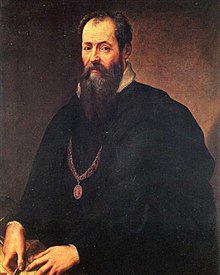 Self-portrait by Vasari | |
| Born | 30 July 1511 Arezzo, Republic of Florence |
| Died | 27 June 1574 (aged 62) Florence, Grand Duchy of Tuscany |
| Nationality | Italian |
| Education | Andrea del Sarto |
| Known for |
|
| Notable work | Biographies of Italian artists |
| Movement | Renaissance |
Life
Vasari was born prematurely on 30 July 1511 in Arezzo, Tuscany.[6] Recommended at an early age by his cousin Luca Signorelli, he became a pupil of Guglielmo da Marsiglia, a skillful painter of stained glass.[7][8] Sent to Florence at the age of sixteen by Cardinal Silvio Passerini, he joined the circle of Andrea del Sarto and his pupils, Rosso Fiorentino and Jacopo Pontormo, where his humanist education was encouraged. He was befriended by Michelangelo, whose painting style would influence his own. He died on 27 June 1574 in Florence, Grand Duchy of Tuscany, aged 62.[6]
Painting
![Six Tuscan Poets by Giorgio Vasari, c. 1544, from left to right: Marsilio Ficino, Cristoforo Landino, Francesco Petrarca, Giovanni Boccaccio, Dante Alighieri, and Guido Cavalcanti[9]](http://upload.wikimedia.org/wikipedia/commons/thumb/2/28/Giorgio_Vasari_-_Six_Tuscan_Poets_-_Google_Art_Project.jpg/220px-Giorgio_Vasari_-_Six_Tuscan_Poets_-_Google_Art_Project.jpg)

In 1529, he visited Rome where he studied the works of Raphael and other artists of the Roman High Renaissance. Vasari's own Mannerist paintings were more admired in his lifetime than afterward. In 1547, he completed the hall of the chancery in Palazzo della Cancelleria in Rome with frescoes that received the name Sala dei Cento Giorni. He was employed consistently by members of the Medici family in Florence and Rome, and worked in Naples (for example on the Vasari Sacristy), Arezzo, and other places. Many of his paintings still exist, the most important being on the wall and ceiling of the Sala di Cosimo I in the Palazzo Vecchio in Florence,[8] where he and his assistants were at work from 1555. Vasari also helped to organize the decoration of the Studiolo, now reassembled in the Palazzo Vecchio.
In Rome, he painted frescos in the Sala Regia. Included among his better-known pupils or followers are Sebastiano Flori, Bartolomeo Carducci, Mirabello Cavalori (Salincorno), Stefano Veltroni (of Monte San Savino), and Alessandro Fortori (of Arezzo).[10]
His last major commission was vast The Last Judgement fresco on the ceiling of the cupola of the Florence Cathedral that he began in 1572 with the assistance of the Bolognese painter Lorenzo Sabatini. Unfinished at the time of Vasari's death it was completed by Federico Zuccari.
Architecture
This section needs additional citations for verification. (November 2021) |
Aside from his career as a painter, Vasari was successful as an architect.[11]

His loggia of the Palazzo degli Uffizi by the Arno opens up the vista at the far end of its long narrow courtyard. It is a unique piece of urban planning that functions as a public piazza, and which, if considered as a short street, is unique as a Renaissance street with a unified architectural treatment. The view of the Loggia from the Arno reveals that, with the Vasari Corridor, it is one of very few structures lining the river that are open to the river and appear to embrace the riverside environment.
In Florence, Vasari also built the long passage, now called Vasari Corridor, which connects the Uffizi with the Palazzo Pitti on the other side of the river. The enclosed corridor passes alongside the River Arno on an arcade, crosses the Ponte Vecchio, and winds around the exterior of several buildings. It was once the home of the Mercado de Vecchio.[12]
He renovated the medieval churches of Santa Maria Novella and Santa Croce. At both, he removed the original rood screen and loft, and remodelled the retro-choirs in the Mannerist taste of his time.[8]
In Santa Croce, he was responsible for the painting of The Adoration of the Magi that was commissioned by Pope Pius V in 1566 and completed in February 1567. It was restored recently, before being put on exhibition in 2011 in Rome and in Naples. Eventually, it will be returned to the church of Santa Croce in Bosco Marengo (Province of Alessandria, Piedmont).
In 1562, Vasari built the octagonal dome on the Basilica of Our Lady of Humility in Pistoia, an important example of High Renaissance architecture.[13]
In Rome, Vasari worked with Giacomo Barozzi da Vignola and Bartolomeo Ammannati at Pope Julius III's Villa Giulia.
The Lives of the Most Excellent Painters, Sculptors, and Architects

Often called "the first art historian",[14] Vasari invented the genre of the encyclopedia of artistic biographies with his Le Vite de' più eccellenti pittori, scultori, ed architettori (Lives of the Most Excellent Painters, Sculptors, and Architects), first published in 1550 and dedicated to Grand Duke Cosimo I de' Medici. He was the first to use the term "Rinascita" (rebirth in Italian) in print – although an awareness of an ongoing "rebirth" in the arts had been in the air since the time of Alberti. Vasari's term, applied to the change in artistic styles with the work of Giotto, eventually would become the French term Renaissance (rebirth) for the era that followed. Vasari was responsible for the modern use of the term Gothic art, as well, although he only used the word Goth in association with the German style that preceded the rebirth, which he identified as "barbaric".
The Lives also included a novel treatise on the technical methods employed in the arts.[15][8] The book was partly rewritten and enlarged in 1568,[8] with the addition of woodcut portraits of artists (some conjectural).[citation needed]
The work has a consistent and notorious bias in favour of Florentines and tends to attribute to them all the developments in Renaissance art – for example, the invention of engraving. Venetian art in particular (along with arts from other parts of Europe), is ignored systematically in the first edition. Between his first and second editions, Vasari visited Venice and while the second edition gave more attention to Venetian art (finally including Titian), it did so without achieving a neutral point of view. [citation needed]
Many inaccuracies exist within his Lives. For example, Vasari writes that Andrea del Castagno killed Domenico Veneziano, which is incorrect; Andrea died several years before Domenico. In another example, Vasari's biography of Giovanni Antonio Bazzi, whom he calls "Il Soddoma", published only in the second edition of the Lives (1568) after Bazzi's death, condemns the artist as being immoral, bestial, and vain. Vasari dismisses Bazzi's work as lazy and offensive, despite the artist's having been named a Cavaliere di Cristo by Pope Leo X and having received important commissions for the Villa Farnese and other sites.[16]
Vasari's biographies are interspersed with amusing gossip. Many of his anecdotes have the ring of truth, while others are inventions or generic fictions, such as the tale of young Giotto painting a fly on the surface of a painting by Cimabue that supposedly, the older master repeatedly tried to brush away, a genre tale that echoes anecdotes told of the Greek painter Apelles. He did not research archives for exact dates, as modern art historians do, and naturally, his biographies are most dependable for the painters of his own generation and those of the immediate past generation. Modern criticism – with new materials opened up by research – has corrected many of his traditional dates and attributions.[8]
Vasari includes a sketch of his own biography at the end of the Lives, and adds further details about him and his family in his lives of Lazzaro Vasari and Francesco Salviati.[8]
According to the historian Richard Goldthwaite,[17] Vasari was one of the earliest authors to use the term "competition" (or "concorrenza" in Italian) in its economic sense. He used it repeatedly, and stressed the concept in his introduction to the life of Pietro Perugino, in explaining the reasons for Florentine artistic preeminence. In Vasari's view, Florentine artists excelled because they were hungry, and they were hungry because their fierce competition amongst themselves for commissions kept them so. Competition, he said, is "one of the nourishments that maintain them".[citation needed]
Social standing
Vasari enjoyed high repute during his lifetime and amassed a considerable fortune. He married Niccolosa Bacci, a member of one of the richest and most prominent families of Arezzo. He was made Knight of the Golden Spur by the Pope. He was elected to the municipal council of his native town and finally, rose to the supreme office of gonfaloniere.[8]
He built a fine house in Arezzo in 1547 and decorated its walls and vaults with paintings. It is now a museum in his honour named the Casa Vasari, whilst his residence in Florence is also preserved.[citation needed]
In 1563, he helped found the Florentine Accademia e Compagnia delle Arti del Disegno, with the Grand Duke and Michelangelo as capi of the institution. Thirty-six artists were chosen as members.[18]
Gallery
- paintings by Giorgio Vasari
- Alessandro de Medici resting
- Pieta
- Bird catchers
- Holy Family, with Andrea del Sarto
- Last Supper
- Entombment
- Temptations of St. Jerome
- St. Luke painting the Virgin
- Annunciation
- Justice
- The Prophet Elisha
- frescos and decorations by Giorgio Vasari
- Interior of the dome of Florence Cathedral
- Cosimo studies the taking of Siena
- Apotheosis of
Cosimo I - Defeat of the Venetians in Casentino
- Libro de' Disegni by Giorgio Vasari
- Giorgio Vasari with drawings by Filippino Lippi, Botticelli, and Raffaellino del Garbo
- Giorgio Vasari with drawings by Filippino Lippi, Botticelli, and Raffaellino del Garbo
- architecture by Giorgio Vasari
- Uffizi colonnade and loggia
- Loggia of Vasari in Arezzo
- Pietro in Montorio, Rome
- Tomb of Michelangelo
- Sala dei Cento Giorni - Giorgio Vasari - 1547 - Palazzo della Cancelleria
- Villa Giulia - Court - Vasari - Vignola
- Part of Loggia del Mercato Vecchio, Florence, just prior to its demolition in the 1880s
References and sources
References
- "Vasari". Collins English Dictionary. HarperCollins. Retrieved 1 June 2019.
- "Vasari, Giorgio" (US) and "Vasari, Giorgio". Oxford Dictionaries UK English Dictionary. Oxford University Press. Archived from the original on 9 November 2021.
- "Vasari". The American Heritage Dictionary of the English Language (5th ed.). HarperCollins. Retrieved 1 June 2019.
- "Vasari". Merriam-Webster Dictionary. Retrieved 1 June 2019.
- Michelet, Jules (1835). Histoire de France: Renaissance. Vol. VII. Paris.
- Gaunt, W. (ed.) (1962) Everyman's dictionary of pictorial art. Volume II. London: Dent, p. 328. ISBN 0-460-03006-X
- "Art in Tuscany | Giorgio Vasari and Italian Renaissance painting | Podere Santa Pia, Holiday house in the south of Tuscany". www.travelingintuscany.com. Retrieved 1 October 2017.
- One or more of the preceding sentences incorporates text from a publication now in the public domain: Chisholm, Hugh, ed. (1911). "Vasari, Giorgio". Encyclopædia Britannica. Vol. 27 (11th ed.). Cambridge University Press.
- "Six Tuscan Poets, Giorgio Vasari". Minneapolis Institute of Art.
- The History of Painting in Italy: The Florentine, Sienese, and Roman schools, by Luigi Lanzi, page 201-202.
- "Vasari's ability as a painter cannot match his talents either as an historian or as an architect," according to Lawrence Gowing, ed., Biographical Encyclopedia of Artists, v.4 (Facts on File, 2005): 695.
- Pevsner, N., A History of Building Types, Princeton University Press, 1979, pg. 235
- The Christian Travelers Guide to Italy by David Bershad, Carolina Mangone, Irving Hexham 2001 ISBN 0-310-22573-6-page
- Vasari, Giorgio Archived 6 November 2018 at the Wayback Machine Dictionary of Art Historians, 2013. Retrieved 26 May 2013.
- Vasari, Giorgio. (1907) Vasari on technique: being the introduction to the three arts of design, architecture, sculpture, and painting, prefixed to the Lives of the most excellent painters, sculptors, and architects. G. Baldwin Brown Ed. Louisa S. Maclehose Trans. London: Dent.
- Zarucchi, Jeanne Morgan (2015). "Vasari's Biography of Bazzi as 'Soddoma:' Art History and Literary Analysis". Italian Studies. 70:2 (2): 167–190. doi:10.1179/0075163415Z.00000000094. S2CID 191976882.
- Richard Goldthwaite, The Economy of Renaissance Florence, 2009, pg. 390.
- Gauvin Alexander Bailey, 'Santi di Tito and the Florentine Academy: Solomon Building the Temple in the Capitolo of the Accademia del Disegno (1570–71)', Apollo CLV, 480 (February 2002): pp. 31–39.
Sources
- The Lives of the Artists Oxford University Press, 1998. ISBN 0-19-283410-X
- Lives of the Painters, Sculptors and Architects, Volumes I and II. Everyman's Library, 1996. ISBN 0-679-45101-3
- Vasari on Technique. Dover Publications, 1980. ISBN 0-486-20717-X
- Life of Michelangelo. Alba House, 2003. ISBN 0-8189-0935-8
- Herbermann, Charles, ed. (1912). . Catholic Encyclopedia. Vol. 15. New York: Robert Appleton Company.
Further reading
- Barriault, Anne B.; Ladis, Andrew T.; Land, Norman E.; Wood, Jeryldene M., eds. (2005). Reading Vasari. London: Philip Wilson.
- Cast, David J., ed. (2013). The Ashgate Research Companion to Giorgio Vasari. Abingdon-on-Thames, Oxfordshire, England: Routledge. doi:10.4324/9781315613017. ISBN 9781409408475.
External links
- Works by Giorgio Vasari at Project Gutenberg
- Works by or about Giorgio Vasari at Internet Archive
- Works by Giorgio Vasari at LibriVox (public domain audiobooks)

- Works by Giorgio Vasari at Open Library
- Biography of Vasari and analysis for four major works
- Petri Liukkonen. "Giorgio Vasari". Books and Writers
- Giorgio Vasari – The First Art-Historian
Copies of Vasari's Lives of the Artists online:
- “Giorgio Vasari's Lives of the Artists.” Site created by Adrienne DeAngelis. Now largely completed in the posting of the Lives, intended to be re-translated to become the unabridged English version.
- Le Vite, 1550 Unabridged, original Italian.
- Stories Of The Italian Artists From Vasari, translated by E L Seeley, 1908. Abridged, in English.
- Le Vite – Edizioni Giuntina e Torrentiniana
- Gli artisti principali citati dal Vasari nelle Vite (elenco)
- Excerpts from the Vite combined with photos of works mentioned by Vasari.
На других языках
[de] Giorgio Vasari
Giorgio Vasari (* 30. Juli 1511 in Arezzo; † 27. Juni 1574 in Florenz) war ein italienischer Architekt, Hofmaler der Medici und Biograph italienischer Künstler. Er schuf als Architekt und Maler beachtliche Werke, ist heute aber vor allem als „der erste Kunsthistoriker“ und „Vater der Kunstgeschichte“ bekannt. Er beschrieb das Leben und Werk zahlreicher italienischer Maler, Bildhauer und Architekten. Seine gesammelten Künstlerbiographien (Le vite, „die Viten“), die er Cosimo I. de’ Medici widmete, gelten als sein Hauptwerk. Sie erschienen 1550 und in einer zweiten, erweiterten Ausgabe 1568, jeweils in Florenz. Die Begriffe Gotik, Renaissance und Manierismus gehen direkt oder indirekt auf Vasaris Vite zurück.- [en] Giorgio Vasari
[es] Giorgio Vasari
Giorgio Vasari (Arezzo, 30 de julio de 1511-Florencia, 27 de junio de 1574) fue un arquitecto, pintor y escritor italiano. Considerado uno de los primeros historiadores del arte, es célebre por sus biografías de artistas italianos, colección de datos, anécdotas, leyendas y curiosidades recogidas en su libro Las vidas de los más excelentes arquitectos, pintores y escultores italianos [Le vite de' più eccellenti pittori, scultori, e architettori italiani, da Cimabue insino a' tempi nostri] (1550; segunda edición ampliada en 1568). Se le atribuye el haber acuñado el término Renacimiento.[fr] Giorgio Vasari
Giorgio Vasari (30 juillet 1511 à Arezzo - 27 juin 1574 à Florence) est un peintre, architecte et écrivain toscan. Son recueil biographique Les Vies des meilleurs peintres, sculpteurs et architectes, particulièrement sa seconde édition de 1568, est considéré comme une des publications fondatrices de l'histoire de l'art.[it] Giorgio Vasari
Giorgio Vasari (Arezzo, 30 luglio 1511 – Firenze, 27 giugno 1574) è stato un pittore, architetto e storico dell'arte italiano.[ru] Вазари, Джорджо
Джо́рджо Ваза́ри (итал. Giorgio Vasari; прозванный Аретино, 30 июля 1511 года , Ареццо — 27 июня 1574 года, Флоренция) — итальянский живописец, архитектор и писатель. Автор знаменитых «Жизнеописаний наиболее знаменитых живописцев, ваятелей и зодчих», один из основоположников современного искусствоведения: источниковедения, историографии и биобиблиографии художников.Другой контент может иметь иную лицензию. Перед использованием материалов сайта WikiSort.org внимательно изучите правила лицензирования конкретных элементов наполнения сайта.
WikiSort.org - проект по пересортировке и дополнению контента Википедии




